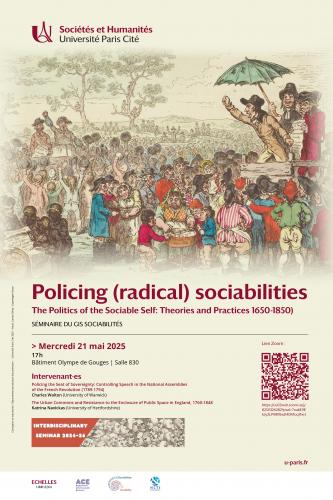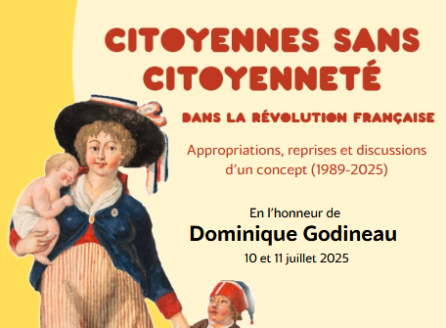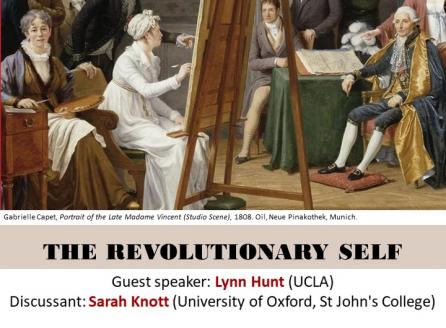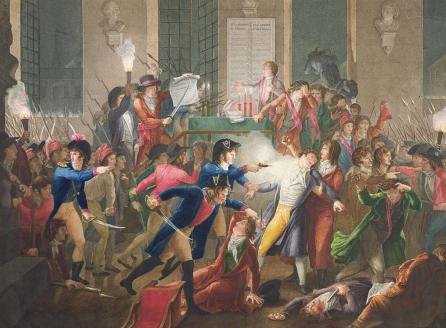GIS Interdisciplinary Seminar: 'Policing (Radical) Sociabilities'
GIS Sociabilités seminar 'The Politics of the ‘Sociable Self: Theories and Practices (1650-1850)'
Fourth thematic session on 'Policing (Radical) Sociabilities, 21 May 2025 (17:00 - 19:00) at the Université de Paris Cité (room 830)
- Charles Walton (University of Warwick) - 'Policing the Seat of Sovereignty: Controlling Speech in the National Assemblies of the French Revolution (1789-1794)'
- Katrina Navickas (University of Hertfordshire) - 'The Urban Commons and Resistance to the Enclosure of Public Space in England, 1760-1848'
Session chaired by John-Erik Hansson (Université Paris Cité) and Chris Fletcher (Université de Lille)
ZOOM LINK: https://us02web.zoom.us/j/82515126282?pwd=7oakE9EkJy2LP1M1f6aJ14DVfuq7be.1
Presentation of talks:
“Policing the Seat of Sovereignty: Controlling Speech in the National Assemblies of the French Revolution (1789-1794)”
This paper discusses the problem of regulating sociability within the revolutionary national assemblies in France between 1789 and the Terror (1793-94). It explores how several factors combined to frustrate the assemblies’ ability to secure the principles of loyal opposition, political compromise and free speech all at once. These factors include the Revolution’s abolition of corporations, which used to have the right to police their own internal affairs. In the post-corporate world of the Revolution, regulations were expected to be generalisable and grounded in the law. The advent of the freedom of expression in 1789, however, complicated the passing of such laws. In the absence of corporate and legal regulations, the internal policing of the national assemblies’ sessions became increasingly subject to the ‘will of the people’. This development jeopardised the national assembly’s autonomy by making it increasingly vulnerable to the external pressure of crowds gathered outside the assembly. This paper offers case studies of the expulsion of national deputies for perceived speech offences between 1789 and the Terror, showing how punitive measures and crowd pressures intensified, culminating in the execution of several deputies in 1793. The paper also examines three proposals advanced by deputies during the Terror to reduce tensions by establishing internal censorship mechanisms. The proposals failed in the face of free speech commitments, insurrectionary crowds and lethal polarisation.
“The Urban Commons and Resistance to the Enclosure of Public Space in England, 1760-1848”
This paper draws from the opening chapters of my next monograph, Contested Commons: a History of Protest and Public Space in England. It argues that urbanisation and industrialisation in England during the long eighteenth century created new public spaces that facilitated political sociability and new sites for popular protest. These sites can be understood as an urban commons. In reaction to the new working-class radical and trades’ movements, the political and social elites sought to control and police such spaces. The enclosure of the agricultural commons in this period was paralleled by a process of urban enclosure, whereby any collective activity in public spaces was increasingly policed or moved out by property owners. The new police introduced in the 1830s and 1840s employed a strategy of ‘move on’ for any groups that did not fit the conservative, capitalist modes of using public space encouraged by propertied elites. The urban commons was enclosed through a process of dispossession. The new political movements, notably the Chartists in the 1840s, resisted urban enclosure by mass occupation and communal uses of such sites. The paper examines a variety of archives from the Home Office, metropolitan police, local government and radical newspapers to show the rapid development of modes of organisation and protest in this period.





